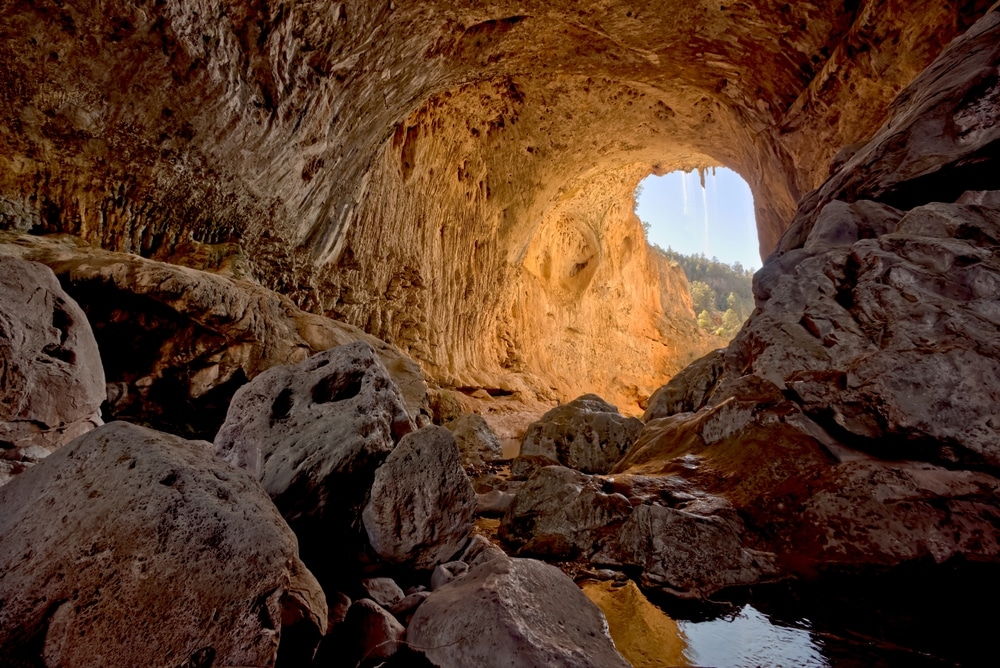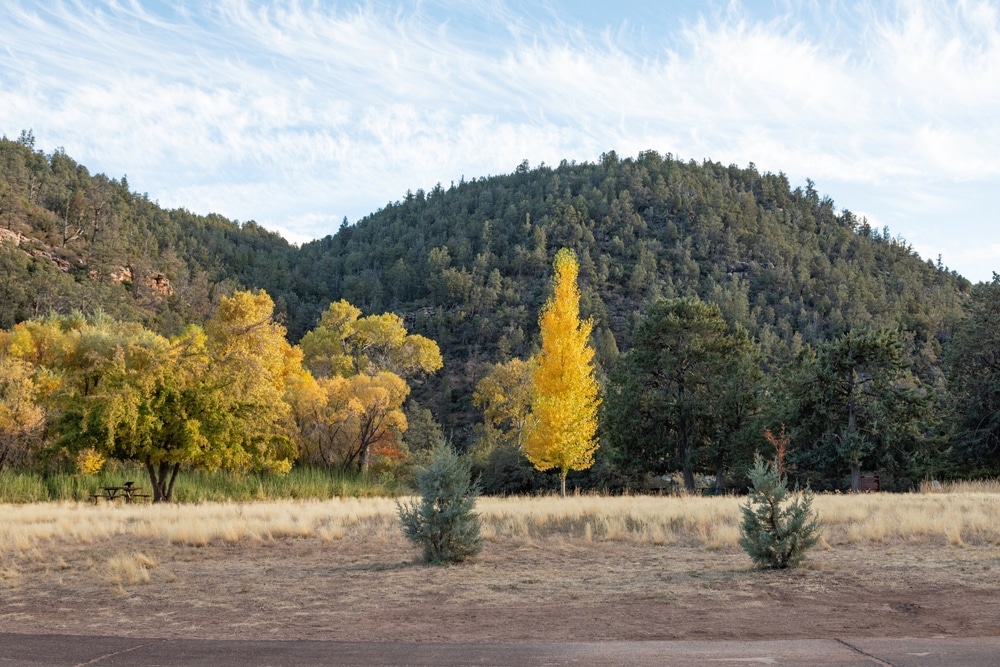- Privacy
- Terms
- Stay Connected
Nestled in a hidden valley among the towering pines of Arizona’s Rim Country, Tonto Natural Bridge State Park protects what is believed to be the largest natural travertine bridge in the world. This geological wonder stands 183 feet high over a 400-foot long tunnel that measures 150 feet wide. The magnificent limestone bridge is the stunning centerpiece of this 150-acre park that provides visitors an opportunity to witness one of Arizona’s most spectacular natural wonders.
The park’s history begins with David Gowan, a prospector who stumbled upon the bridge in 1877 while fleeing from Apache tribal members. Amazed by the natural formation, Gowan claimed the land surrounding the bridge by squatter’s rights and persuaded his family to join him from Scotland. The Gowan family settled the land and lived in a cabin on top of the bridge, which they operated as a tourist attraction until 1948. After changing hands several times, the area was purchased by the state of Arizona and officially opened as a state park in 1991, ensuring this natural treasure would be preserved for future generations.

Located just 10 miles north of Payson (GPS coordinates: 34.3183° N, 111.4543° W), the park sits at an elevation of approximately 4,530 feet in Tonto National Forest. This positioning places it in a transitional zone between the desert ecosystems to the south and the pine forests of the Mogollon Rim to the north, creating a unique ecological setting with diverse plant and animal communities.
As part of Arizona’s state park system, Tonto Natural Bridge represents one of the state’s most distinctive geological features and serves as a testament to the diverse landscapes that make Arizona a premier destination for outdoor enthusiasts. Unlike the desert parks that dominate much of the state’s protected areas, Tonto Natural Bridge offers a lush, verdant environment with flowing water—a rare and precious resource in Arizona.
Visitors to the park can explore multiple viewpoints of the bridge, hike to the creek bottom to experience the bridge from below, observe the crystal-clear springs that feed Pine Creek, and discover the unique travertine formations that continue to grow and evolve. The combination of spectacular geology, rich history, diverse wildlife, and recreational opportunities makes Tonto Natural Bridge State Park one of Arizona’s most captivating natural attractions.

The combination of flowing water, travertine formations, and forest canopy creates exceptional photography opportunities throughout the seasons. Morning light illuminates the eastern face of the bridge, while afternoon sun penetrates the canyon with dramatic light beams. Spring wildflowers, summer greenery, fall colors, and occasional winter snow each transform the landscape in distinctive ways, rewarding repeat visits with entirely different photographic possibilities.

The park’s centerpiece is the spectacular natural bridge, believed to be the largest travertine arch in the world. Four viewpoints along the rim provide stunning perspectives of this 183-foot-high natural formation spanning 400 feet across Pine Creek. Each viewpoint offers distinctive angles for observing the massive limestone formation, allowing visitors to appreciate its scale and unique geological features. The easily accessible observation areas make it possible for visitors of all mobility levels to experience this natural wonder.

The waterfall-fed travertine system has created numerous small caves and alcoves throughout the canyon. The Anna Mae Trail passes through a travertine cave formation with dripping mineral-rich water that continues to build new formations. These grottos feature unique plant communities adapted to the specialized environment and showcase the ongoing geological processes that formed the bridge over thousands of years.

During warmer months, the clear pools beneath the bridge provide refreshing swimming and wading opportunities. The spring-fed creek maintains relatively stable water temperatures and creates natural swimming holes with travertine bottoms. These peaceful pools offer a unique swimming experience surrounded by towering canyon walls and lush vegetation not typically associated with Arizona landscapes.

The park’s unique riparian habitat supports diverse bird species not commonly found in drier Arizona environments. Canyon wrens, violet-green swallows, and numerous warbler species inhabit the bridge area, while the surrounding forest hosts Acorn Woodpeckers, Steller’s Jays, and occasional Wild Turkeys. The visitor center provides bird checklists to help identify species commonly seen throughout the park.

The park preserves a historic lodge built in the 1920s by David Gowan’s descendants, showcasing early Arizona tourism development. This rustic structure features period furnishings and exhibits explaining the property’s transition from homestead to tourist destination. The lodge’s wide porches offer peaceful resting spots with panoramic views after hiking the canyon trails.

Multiple day-use areas around the historic lodge offer picnic tables with spectacular views of the surrounding Mogollon Rim country. These facilities are situated among towering ponderosa pines providing natural shade during midday hours. Additional picnic areas near the trailheads allow for convenient meals before or after exploring the natural bridge.

| Category | Information |
|---|---|
| Location | Pine, Arizona, about 10 miles north of Payson in central Arizona |
| Established | 1991 (as a state park) |
| Size | 183 acres |
| Natural Feature | World’s largest natural travertine bridge, standing 183 feet high with a 400-foot long tunnel that’s approximately 150 feet wide |
| Geology | Formed by travertine (calcium carbonate) deposited by mineral springs over thousands of years |
| Historical Discovery | First documented by David Gowan, a Scottish prospector who discovered it while being pursued by Apache Indians in 1877 |
| Historical Ownership | David Gowan claimed the land under the Homestead Act in 1883; property was purchased by the State of Arizona in 1990 |
| Elevation | Approximately 4,530 feet |
| Flora | Pine forests, sycamore, walnut, and various riparian plant species |
| Fauna | Javelina, deer, raccoons, various bird species, and occasionally black bears |
| Hiking Trails | Four viewpoint trails: Pine Creek Trail, Waterfall Trail, Gowan Trail, and Anna Mae Trail (ranging from moderate to difficult) |
| Water Features | Pine Creek, waterfall, and natural springs |
| Facilities | Visitor center, picnic areas, gift shop, restrooms, and observation decks |
| Activities | Hiking, photography, picnicking, wildlife viewing, and nature study |
| Operating Hours | Typically 9 AM to 5 PM daily (hours may vary seasonally) |
| Best Time to Visit | Spring through fall, especially spring when waterflow is highest |
| Climate | Four distinct seasons; summer temperatures average 80-90°F, winter can see snow and freezing temperatures |
| Admission Fees | $7 for adults, $4 for ages 7-13, free for children 6 and under (as of last available data) |
| Accessibility | Partial accessibility for those with mobility challenges; viewpoints accessible but trails can be steep |
| Nearby Attractions | Payson, Mogollon Rim, Tonto National Forest |
| Contact Information | Phone: (928) 476-4202, Website: azstateparks.com/tonto |
The crown jewel of the park, Tonto Natural Bridge, stands as a testament to nature’s patient artistry. This massive travertine arch rises 183 feet above Pine Creek, spans 400 feet in length, and reaches a width of 150 feet at its widest point. The bridge’s dimensions make it the largest natural travertine bridge known in the world, a distinction that draws geologists and nature enthusiasts from across the globe.
Unlike many natural bridges formed by water eroding through sandstone, Tonto Natural Bridge was created through a process involving calcium carbonate deposition. The bridge formation began thousands of years ago when springs deposited calcium carbonate (travertine) over Pine Creek. As the creek continued to flow, it gradually carved a tunnel through the soft travertine, while the deposition process simultaneously reinforced the bridge from above. This ongoing geological process continues today, with calcium carbonate still being deposited by the mineral-rich waters, slowly altering the bridge’s appearance over time.
Pine Creek, which flows through the tunnel beneath the bridge, is a perennial stream fed by springs that emerge from the canyon walls. The creek drops approximately 200 feet along its course through the park, creating a series of small waterfalls and pools. These springs produce approximately 300 gallons of water per minute, maintaining the creek’s flow even during Arizona’s dry seasons.
The canyon surrounding the bridge features steep limestone walls that rise dramatically from the creek bed. The walls display distinct geological strata, telling the story of the region’s geological past. Fossilized plants and marine organisms can occasionally be found in the limestone, evidence of the area’s ancient history as a shallow sea floor.
Beyond the bridge, the park encompasses a diverse landscape including riparian areas along Pine Creek, open meadows, and pine-covered hills. The park sits within the watershed of the East Verde River, which eventually joins the Verde River—one of Central Arizona’s most important waterways. This strategic location in the watershed contributes to the park’s lush environment and biodiversity.
The varying elevation within the park—from approximately 4,530 feet at the visitor center to about 4,200 feet at the creek level—creates microclimates that support different plant communities. The combination of reliable water, diverse terrain, and strategic elevation makes the park an ecological island in a region where water resources are typically scarce and precious.
Geologists continue to study the bridge, monitoring the ongoing deposition process and the subtle changes in the formation’s structure. The bridge serves as an accessible example of travertine formation, providing educational opportunities for visitors to understand the dynamic processes that shape Earth’s surface.
Tonto Natural Bridge State Park’s unique location in a transitional zone between desert and mountain ecosystems creates a diverse habitat supporting a rich variety of plant and animal species. The perennial water source of Pine Creek further enhances this biological diversity, making the park an exceptional place for wildlife viewing and plant observation.
The plant communities within the park vary based on elevation, sun exposure, and proximity to water. The riparian areas along Pine Creek feature water-loving species such as Fremont cottonwood, Arizona sycamore, and various willows. These large deciduous trees provide essential shade and habitat for numerous wildlife species. The understory in these moist areas includes moisture-loving ferns, mosses, and horsetails.
As you move upslope from the creek, the vegetation transitions to a woodland community dominated by Arizona walnut, velvet ash, and netleaf hackberry. Further up the canyon walls, visitors will encounter typical Transition Zone species including ponderosa pine, pinyon pine, alligator juniper, and Gambel oak. The park also hosts several species of agave, yucca, and prickly pear cactus in its drier areas, reflecting the park’s position on the edge of more arid ecosystems.
Spring and summer bring vibrant wildflower displays to the park, including columbine, monkey flower, and various penstemons. The travertine formations themselves host specialized plant communities adapted to the mineral-rich environment, including some species of algae and mosses that contribute to the ongoing formation process.
The diverse plant life supports an equally varied animal community. Mammals frequently spotted in the park include white-tailed deer, javelina, gray fox, bobcat, and various species of squirrels and rabbits. More elusive residents include ringtail cats, skunks, and the occasional black bear or mountain lion passing through the area.
Birdwatchers will be delighted by the park’s avian diversity, with over 100 species documented within its boundaries. Year-round residents include acorn woodpeckers, canyon wrens, northern cardinals, and several species of jays and nuthatches. Summer brings migratory species such as black-headed grosbeaks, summer tanagers, and various flycatchers. The riparian corridor serves as a critical migration route, providing resources for birds traveling between their summer and winter ranges.
The clear waters of Pine Creek support native fish species including Gila chub and speckled dace, along with introduced species such as rainbow trout. Reptiles and amphibians found in the park include the Arizona black rattlesnake, gophersnake, several lizard species, Woodhouse’s toads, and canyon treefrogs. The endangered Chiricahua leopard frog has historically been documented in the area, though current populations require ongoing monitoring.
Seasonal changes dramatically affect wildlife activity in the park. Spring brings the birth of fawns and other young animals, along with the return of migratory birds. Summer sees increased reptile activity and vibrant insect populations, including various butterflies and dragonflies. Fall brings increased foraging activity as animals prepare for winter, while winter offers opportunities to observe year-round residents against a occasionally snow-dusted landscape.
The park’s diverse ecological communities provide visitors with year-round wildlife viewing opportunities, making Tonto Natural Bridge State Park a premier destination for nature enthusiasts interested in Arizona’s unique flora and fauna.
Tonto Natural Bridge State Park offers a remarkable variety of recreational activities centered around its namesake geological wonder and the pristine natural environment. From challenging hikes to leisurely picnics, the park provides options for visitors of all ages and ability levels.
Water activities in the park primarily focus on Pine Creek, which flows beneath the natural bridge. While swimming is permitted in designated areas of the creek when water conditions allow, visitors should exercise caution as the rocks can be slippery and water temperatures remain cool even in summer months. The small pools that form along the creek offer refreshing places to wade and cool off during hot summer days. Note that the park does not permit boating or paddling on Pine Creek due to its small size and sensitive environmental conditions.
For fishing enthusiasts, Pine Creek provides limited opportunities to catch small trout in the deeper pools. Anglers must possess a valid Arizona fishing license, and the park encourages catch-and-release practices to maintain fish populations. The best fishing spots are typically found in the deeper pools downstream from the bridge. Fishing is best in spring and early summer before water levels potentially decrease.
Hiking is perhaps the most popular activity at Tonto Natural Bridge, with four designated trails offering varying perspectives of the bridge and surrounding canyon:
Pine Creek Trail (0.5 miles, difficult): This steep trail leads from the parking area down to Pine Creek, passing through the cave-like area beneath the bridge. The trail involves some rock scrambling and can be slippery when wet, requiring sturdy footwear and good mobility.
Gowan Trail (0.5 miles, moderate to difficult): Named after the park’s first settler, this trail provides an alternative route down to Pine Creek, offering different perspectives of the bridge. It features steps and handrails in the steeper sections.
Waterfall Trail (0.3 miles, moderate): This short but rewarding trail leads to a small waterfall that cascades over travertine formations. The trail offers excellent views of the lush vegetation surrounding the creek.
Anna Mae Trail (0.6 miles, moderate): This trail connects various observation points, providing panoramic views of the bridge and canyon. It’s an excellent choice for those who prefer not to descend to the creek level.
Photography opportunities abound throughout the park, with the bridge itself being the primary subject. Morning light provides dramatic shadows within the tunnel beneath the bridge, while afternoon sun illuminates the travertine formations with a golden glow. The viewpoints along the rim offer expansive compositions that capture the bridge in its landscape context. Seasonal variations provide changing photographic opportunities, from spring wildflowers to autumn colors to occasional winter snow dustings.
Stargazing has become increasingly popular at Tonto Natural Bridge, particularly during special events when the park occasionally extends its hours into the evening. The park’s relatively remote location and minimal light pollution create excellent conditions for observing the night sky. During these special events, amateur astronomers often bring telescopes and share their knowledge with other visitors.
For those preferring less strenuous activities, the park features several observation decks that provide spectacular views of the bridge without requiring a descent into the canyon. These accessible viewpoints ensure that visitors of all mobility levels can experience the bridge’s grandeur. Picnic areas throughout the park offer peaceful settings for relaxed meals amid the natural beauty.
Throughout the year, the park hosts various ranger-led programs, including geology talks, wildlife walks, and historical presentations about the Gowan family and their life at the bridge. These programs enhance the visitor experience by providing deeper context and understanding of this remarkable natural feature.
Unlike many of Arizona’s state parks, Tonto Natural Bridge State Park does not offer traditional campground facilities within the park boundaries. The park is primarily designed for day-use visitors, with operations typically running from 9:00 AM to 5:00 PM (extended to 6:00 PM during summer months). However, accommodation options both within and near the park ensure visitors can extend their stay to fully experience this natural wonder.
The park does feature a unique lodging opportunity in the historic Goodfellow Lodge, formerly the lodge built by the Gowan family. This rustic building has been renovated to provide comfortable overnight accommodations while maintaining its historic character. The lodge features eight rooms, each with private bathrooms, and can accommodate up to 16 guests total. Amenities include air conditioning, heating, and basic furnishings. Each room offers a distinctive experience, with some providing views of the surrounding forest or meadow areas. As the only lodging option within the park itself, Goodfellow Lodge books quickly during peak seasons, and reservations should be made well in advance through the Arizona State Parks reservation system or by calling the park directly.
For visitors seeking traditional camping experiences, several options exist in close proximity to the park:
Houston Mesa Recreation Area, located approximately 15 miles south of the park near Payson, offers developed campgrounds with tent and RV sites. Managed by the Tonto National Forest, this area features over 74 campsites with amenities including drinking water, vault toilets, and fire rings. Some sites are available on a first-come, first-served basis, while others can be reserved through the Recreation.gov website.
Flowing Springs Campground, about 13 miles from the park, provides a more rustic camping experience along the East Verde River. This U.S. Forest Service campground offers primitive sites with limited amenities, appealing to those seeking a more natural experience.
Payson Area Campgrounds include several private RV parks and campgrounds that offer full hookups and additional amenities such as showers, laundry facilities, and WiFi. These options range from budget-friendly to more deluxe accommodations and are located within a 20-minute drive of Tonto Natural Bridge State Park.
For visitors preferring hotel accommodations, the town of Payson, located just 10 miles south of the park, offers numerous options ranging from budget motels to more upscale lodging. Chain hotels, locally owned motels, and bed and breakfast establishments provide a variety of choices to suit different preferences and budgets. During summer weekends and throughout the fall colors season, Payson accommodations fill quickly, and advance reservations are highly recommended.
Vacation rentals have become increasingly popular in the Rim Country area, with many cabins and homes available through various booking platforms. These rentals range from cozy one-bedroom cabins to larger properties that can accommodate groups or families, often featuring extras such as fireplaces, hot tubs, and forest views.
For those planning to stay overnight in the area, it’s essential to understand local regulations regarding food storage and waste disposal, particularly in areas frequented by wildlife. All of the nearby camping areas enforce restrictions on campfires during periods of high fire danger, typically in late spring and early summer before the monsoon season begins.
Visitors with RVs should note that while the park’s parking areas can accommodate large vehicles for day use, there are no overnight RV parking facilities within the park itself. The nearest dump stations are located at Houston Mesa Recreation Area and at some of the private RV parks in Payson.
Tonto Natural Bridge State Park operates year-round with standard hours of 9:00 AM to 5:00 PM, extending to 6:00 PM during summer months (May through September). The park is closed on Christmas Day but remains open on all other holidays, often with increased visitation on these days.
Each season offers a distinct experience at the park:
Current entrance fees (as of 2025) are:
The park accepts cash, credit cards, and debit cards for payment. Annual passes to Arizona State Parks are available and provide significant savings for frequent visitors. The “Premium” annual pass ($85) includes admission to all Arizona State Parks, while the “Standard” pass ($60) excludes Lake Havasu and Cattail Cove State Parks. Active military members receive a discount on daily entrance fees with ID.
The park experiences its highest visitation during weekends from May through October, with holiday weekends being exceptionally busy. For a more peaceful experience, consider visiting on weekdays, particularly Tuesday through Thursday, when crowds are typically smallest. Early mornings offer the best lighting for photography and increased chances of wildlife sightings.
For those seeking specific experiences, late April to early May often provides the best wildflower displays, while late October typically offers peak fall foliage. Winter visits after a snowfall present unique photography opportunities, though trail conditions may be challenging.
The park’s elevation at approximately 4,530 feet creates a climate distinct from both the Phoenix valley and the higher Mogollon Rim. Average high temperatures range from 56°F in January to 91°F in July, with overnight lows spanning from 27°F in winter months to 65°F in summer.
Summer visitors should be prepared for afternoon thunderstorms during monsoon season (July-September), while winter visitors may encounter snow and icy conditions, particularly on the trails leading down to the creek. Spring and fall generally offer the most stable weather conditions, though temperature swings of 30-40 degrees between night and day are common during these transitional seasons.
Tonto Natural Bridge State Park has made significant efforts to accommodate visitors with varying mobility needs. The visitor center, gift shop, and restrooms are wheelchair accessible. Several observation viewpoints offering perspectives of the bridge can be accessed via paved pathways suitable for wheelchairs and those with limited mobility.
It’s important to note that the trails leading down to the creek and beneath the bridge involve steep grades, uneven surfaces, and in some cases, rock scrambling that may be challenging or impossible for those with mobility limitations. The Pine Creek Trail and Gowan Trail, while offering the most immersive experience of the bridge, are not accessible to wheelchair users or those unable to navigate steep, uneven terrain.
The park provides a detailed trail guide with accessibility ratings to help visitors plan appropriate activities based on their abilities. Accessible parking spaces are available near the visitor center and main viewpoints.
Pets are welcome at Tonto Natural Bridge State Park but must be kept on leashes no longer than six feet at all times. Pet owners are required to clean up after their animals, and disposal bags are provided at several locations throughout the park. While pets are permitted on the trails, the steep and sometimes slippery terrain of Pine Creek Trail and Gowan Trail may prove challenging for some animals. During summer months, trail surfaces can become hot enough to damage paw pads, and pet owners should carry water for their animals.
Pets are not permitted inside the visitor center or Goodfellow Lodge, with the exception of service animals as defined by the Americans with Disabilities Act.
Cell service within the park is limited and varies by carrier. Verizon typically provides the most reliable coverage, while other carriers may have weak signals or no service at all, particularly at creek level and beneath the bridge. The visitor center offers free WiFi during operating hours, though bandwidth is limited. Visitors should download maps, make important calls, and handle online needs before entering the park. For safety reasons, visitors hiking to the creek level should inform someone of their plans and expected return time.
Tonto Natural Bridge State Park offers a range of facilities and amenities designed to enhance the visitor experience while preserving the natural environment. These services provide comfort and convenience while maintaining the park’s natural character.
The Visitor Center serves as the park’s primary information hub and is typically the first stop for new visitors. Located near the main parking area, this facility houses interpretive displays detailing the geological formation of the bridge, the park’s ecological significance, and the human history of the area. Knowledgeable park staff are available to answer questions, provide trail recommendations based on visitor interests and abilities, and offer updates on current park conditions. The center also contains a small exhibit of historical photographs documenting the Gowan family’s tenure at the property and the evolution of the park over time.
Adjacent to the Visitor Center, the Gift Shop offers a selection of books about Arizona geology and natural history, field guides to local flora and fauna, and various souvenirs including t-shirts, postcards, and locally made craft items. A selection of snacks, cold beverages, and basic hiking supplies such as sunscreen and first aid items are also available for purchase. The shop accepts major credit cards, debit cards, and cash.
Restroom facilities are located at several points throughout the park, including near the main parking area, at the picnic grounds, and at the Goodfellow Lodge. The main restrooms feature flush toilets, sinks with running water, and are ADA accessible. More limited facilities (vault toilets) are available at some of the trailheads. During peak visitation periods, portable restrooms may be added to accommodate increased demand.
The park features several picnic areas with tables, benches, and shade structures. The main picnic area includes approximately 15 tables distributed through a shaded grove of trees near the visitor center. Each site features a table and adjacent grill, with nearby access to water and restrooms. For larger groups, three ramadas can be reserved in advance for a nominal fee. These covered structures accommodate up to 40 people each and include multiple tables, larger grills, and proximity to restrooms. Reservation information is available through the park office or the Arizona State Parks website.
Given the park’s focus on the natural bridge and Pine Creek, there are no boat ramps or marina facilities. The park does not offer equipment rentals for water activities.
For families with children, a small playground is located near the main picnic area, providing basic play equipment suitable for children aged 5-12. The natural environment of the park, including the creek bed (when conditions permit safe access), offers children opportunities for exploration and discovery.
The park does not contain gas stations, ATMs, or medical facilities. The nearest gas station is located approximately 7 miles south of the park on Highway 87, while the closest medical facilities are in Payson, approximately 10 miles south. Visitors requiring these services should plan accordingly.
Trash and recycling receptacles are positioned strategically throughout the park. Visitors are encouraged to pack out what they pack in, particularly when exploring the trails, where carrying capacity for waste management is more limited.
The Goodfellow Lodge, beyond providing overnight accommodations, contains a community room occasionally used for small special events, educational presentations, and park programs. The lodge grounds feature historical artifacts related to the site’s past, including original equipment from the Gowan homestead.
Water fountains and bottle filling stations are available near the visitor center and main picnic area. During summer months, misting stations may be activated in the picnic area to provide relief from the heat.
Park maintenance staff work diligently to ensure facilities remain clean and functional. Visitors noticing any maintenance issues are encouraged to report them to park staff to enable prompt attention and repair.
While Tonto Natural Bridge State Park offers enough activities to fill a day or more, its strategic location in Arizona’s Rim Country provides easy access to numerous complementary attractions that can enhance a visit to the region.
Just 10 miles south of the park, the town of Payson serves as the hub of Rim Country and offers various amenities including restaurants, shopping, and cultural attractions. The Rim Country Museum and Zane Grey Cabin provides insights into the area’s pioneer history and connections to the famous Western novelist who spent significant time in the region. The Payson Farmers Market, held Saturday mornings from May through October, showcases local produce, artisanal foods, and crafts from around the region.
The small community of Pine, located just 3 miles from the park, features several local restaurants, antique shops, and the Pine-Strawberry Museum, which documents the area’s ranching and farming heritage. The community’s Pine Community Center hosts various events throughout the year, including craft fairs, community dinners, and seasonal celebrations.
For wine enthusiasts, the Rim Country Wine Trail connects several vineyards and tasting rooms in the Pine-Strawberry area, offering locally produced wines that reflect the unique growing conditions of Arizona’s higher elevations.
Approximately 20 miles northeast of Tonto Natural Bridge, the Mogollon Rim presents one of Arizona’s most dramatic geological features—a 2,000-foot escarpment stretching 200 miles across central Arizona. The Rim Road (Forest Road 300) offers spectacular viewpoints and access to numerous hiking trails, including segments of the historic Arizona Trail. Woods Canyon Lake and Willow Springs Lake, both located atop the Rim, provide fishing, boating, and additional camping opportunities within a 45-minute drive of the park.
Fossil Creek, a designated Wild and Scenic River approximately 30 miles from the park, offers spectacular riparian scenery and swimming opportunities. Note that access to Fossil Creek requires permits during the April-October high season, which should be reserved well in advance through Recreation.gov.
Water Wheel Falls, located approximately 15 miles from Tonto Natural Bridge, offers a moderate hiking experience leading to a series of cascades and swimming holes along the East Verde River. This trail is particularly popular during summer months when the cooling waters provide relief from the heat.
For those interested in Native American history, the Shoofly Village Ruins archaeological site is located just 7 miles from Tonto Natural Bridge. This 4-acre Mogollon culture site features the remains of a 79-room pueblo occupied between 1000 and 1250 CE. Interpretive signs guide visitors through the site, explaining the cultural significance and architectural features of this ancient community.
Several local outfitters in Payson offer guided experiences including jeep tours, horseback riding, and fly fishing expeditions that provide alternative ways to experience the region’s diverse landscapes. These guided experiences can be particularly valuable for visitors seeking specialized knowledge or access to less-traveled areas.
When planning excursions to these nearby attractions, consider seasonality and access issues. Winter snow can temporarily close some high-elevation sites, while summer heat may make lower-elevation destinations uncomfortable during midday hours. The Tonto National Forest, which surrounds much of the area, requires a recreation pass for many of its sites, available at the forest service office in Payson or at various retail locations throughout the region.
Tonto Natural Bridge State Park represents not only a spectacular natural wonder but also a significant conservation success story. The protection of this unique geological feature ensures that future generations can experience its beauty while supporting the diverse ecosystem it harbors.
The Arizona State Parks system manages Tonto Natural Bridge with a dual focus on preservation and access. Ongoing conservation efforts at the park include monitoring of the travertine formation process, which continues to modify the bridge over time. Park scientists regularly document changes in the bridge’s structure, which provides valuable data on geological processes and helps inform management decisions.
Water quality monitoring of Pine Creek represents another critical conservation activity, as the creek’s health directly impacts both the geological processes forming the bridge and the diverse riparian ecosystem. Regular testing assesses potential impacts from visitor use and surrounding land activities, ensuring that the water remains suitable for wildlife and safe for limited recreational use.
Invasive species management constitutes a significant aspect of the park’s environmental stewardship. Staff and volunteers work diligently to monitor and remove non-native plants that could displace native species or alter the park’s ecological balance. Current efforts focus particularly on managing buffelgrass, fountain grass, and tree of heaven, which pose threats to native plant communities throughout central Arizona.
Visitors play a crucial role in conservation efforts through their responsible behavior within the park. The park staff actively promotes “Leave No Trace” principles through interpretive signage, ranger programs, and visitor education materials. These principles include:
For visitors interested in contributing more directly to conservation efforts, the park offers several volunteer opportunities. The Park Host program allows individuals to live on-site for extended periods while assisting with visitor services and maintenance activities. Citizen Science initiatives invite visitors to participate in wildlife monitoring, phenology studies tracking seasonal changes, and special inventory events such as bird counts. These programs provide valuable data while offering participants deeper engagement with the park’s natural systems.
Educational programs constitute another aspect of the park’s stewardship mission. Regularly scheduled ranger talks address topics ranging from geology and hydrology to wildlife and cultural history. Junior Ranger activities engage younger visitors in age-appropriate learning about conservation concepts. For school groups, the park offers curriculum-based field trip opportunities that align with Arizona science education standards.
Beyond on-site education, the park participates in outreach programs to surrounding communities, with rangers occasionally visiting local schools and community events to share information about the park’s natural resources and conservation needs.
The Friends of Tonto Natural Bridge State Park, a volunteer non-profit organization, supports conservation efforts through fundraising, volunteer coordination, and advocacy. This group hosts special events, purchases educational materials and equipment, and works to build community support for the park’s mission.
Climate change poses emerging challenges for park management, potentially affecting water availability, fire regimes, and species distribution. Park staff work with researchers from Arizona universities to monitor climate impacts and develop adaptation strategies to protect the park’s resources in a changing environment.
Through these combined efforts of professional staff, dedicated volunteers, and responsible visitors, Tonto Natural Bridge State Park continues to balance recreational access with conservation, ensuring that this remarkable natural feature remains pristine for generations to come.
The land encompassing Tonto Natural Bridge holds deep cultural significance for indigenous peoples, particularly the Western Apache and Yavapai, who have inhabited the region for centuries. These communities utilized the reliable water source of Pine Creek and the shelter provided by the canyon’s many caves and overhangs. Archaeological evidence suggests human presence in the area dating back at least 1,000 years.
For the Western Apache, the area was part of their traditional territory, and Pine Creek served as a travel corridor between seasonal settlements. The bridge itself appears in traditional stories as a place of spiritual significance. Out of respect for these cultural connections, visitors are asked to treat the area with reverence and to leave any archaeological artifacts they might encounter undisturbed, reporting their location to park staff.
European-American settlement began with David Gowan’s arrival in 1877, marking the beginning of a new cultural chapter for the site. The Gowan family’s Scottish heritage influenced the early development of the area, including architectural elements still visible in the historic lodge. The transition from private ownership to public parkland in 1991 represented a commitment to preserving both the natural wonder and its cultural heritage for future generations.
Today, Tonto Natural Bridge State Park serves as a place where visitors from diverse backgrounds can connect with Arizona’s natural and cultural history, fostering appreciation for both the geological wonder and the human stories interwoven with this remarkable landscape.
How long does it take to hike to the bottom of the bridge?
Depending on your pace and physical condition, the hike down takes approximately 20-30 minutes, with the return uphill journey taking 30-45 minutes.
Is the park suitable for young children?
Yes, though the steep trails to the creek require close supervision. The viewpoints and picnic areas are appropriate for all ages.
Can we swim in the creek?
Wading and limited swimming are permitted when water conditions allow, but the creek is typically shallow and cold. There are no lifeguards on duty.
Are drones allowed in the park?
No, the use of drones is prohibited within all Arizona State Parks without special permission.
What is the best time of year to visit?
Spring (April-May) and fall (October-November) offer the most comfortable temperatures and beautiful scenery, though the park is open and accessible year-round.